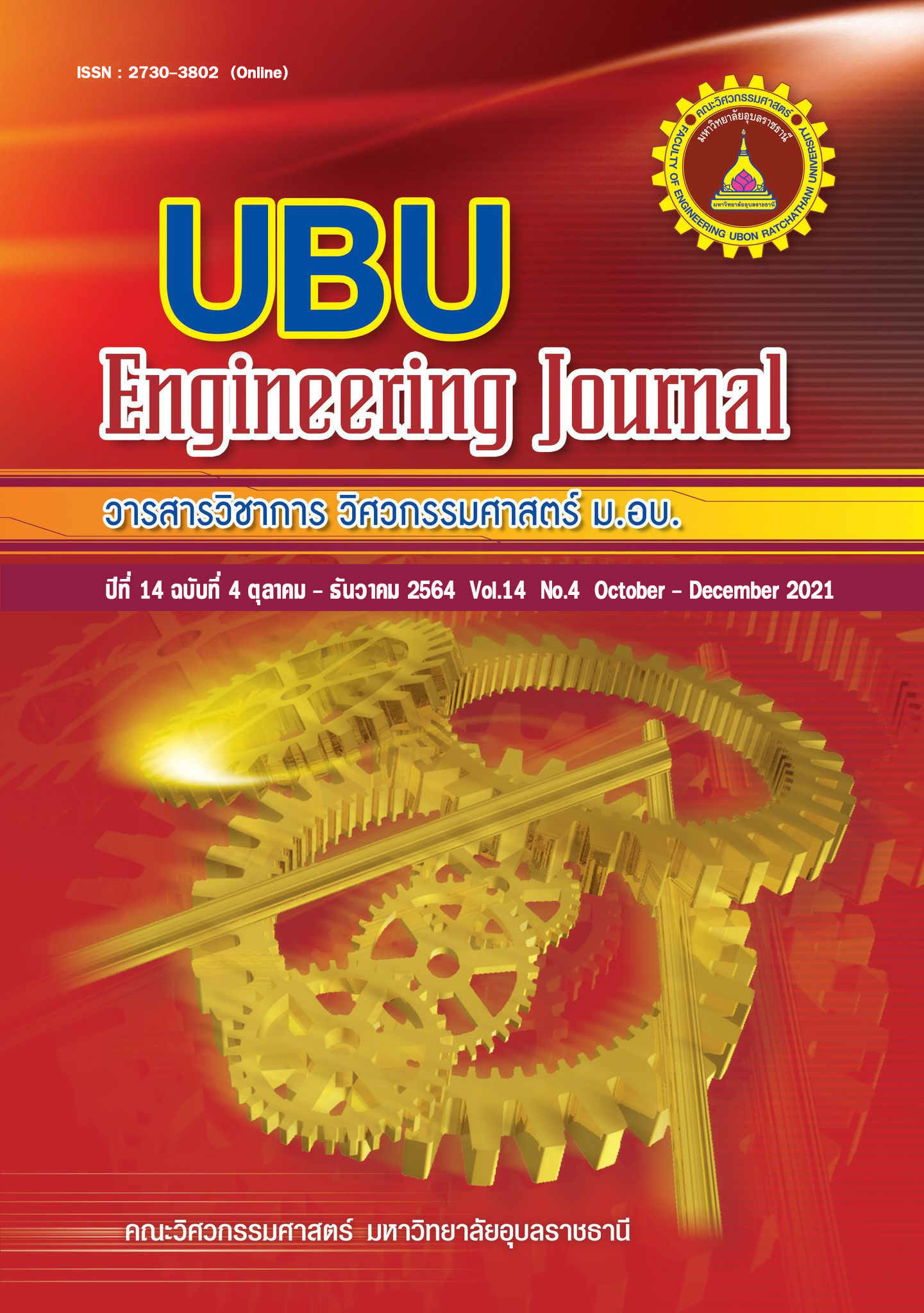Influence of concentrations on aniline removal and aniline degradation kinetics by Pseudomonas fluorescens MC46
Main Article Content
Abstract
Aniline is an aromatic amine widely contaminated in environment. This study aimed to investigate influence of aniline concentrations on aniline removal, aniline biodegradation kinetics, and intermediate product monitoring. Pseudomonas fluorescens strain MC46 (MC46), which is a choloaniline-degrading bacterium, was chosen. The result showed that MC46 (108 CFU/mL) could remove aniline (1-100 mg/L) for approximately 17-43%. The experiments with low initial aniline concentrations (1-10 mg/L) well performed while MC46 cell numbers and aniline removal efficiencies were obviously lower during the experiments with high initial aniline concentrations (30-100 mg/L). Inhibitory aniline removal kinetic analysis followed Andrews model with maximum specific aniline removal rate (qmax) of 1.68x10-4 mg/L/CFU/L-d, half-saturation coefficient (Ks) of 9.7 mg/L, and Inhibition constant (Ki) 13.9 mg/L. From the intermediate product monitoring, catechol occurred during the experiment but MC46 could degrade catechol as well. The result from this study indicated possibility of MC46 for aniline and intermediate product removal practice in the future.
Article Details
References
[2] Bose RS, Dey S, Saha S, Ghosh CK, Chaudhuri MG. Enhanced removal of dissolved aniline from water under combined system of nano zero-valentiron and Pseudomonas putida. sustainable water resources management journal. 2016; 2(2): 143-159.
[3] Northcott J. Kirk-Othmer Encyclopaedia of Chemical Technology. 3rd. Vol. 2. Ontario (Canada): John Wiley & Sons publishers; 1978. 309.
[4] Zakari S, Liu H, Zhou H. Transport velocities of aniline and nitrobenzene in sandy sediment. Journal of Soils and Sediments. 2019; 19(5): 2570-2579.
[5] Sun W, Li Y, McGuinness LR, Luo S, Huang W, Kerkhof LJ, Mack EE, Häggblom MM, Fennell DE. Identification of anaerobic aniline-degrading bacteria at a contaminated industrial site. Environmental Science and Technology. 2015; 49(18): 11079-11088.
[6] Dewage NB, Liyanage AS, Smith Q, Pittman J, Charles U, Perez F, Hassan EB, Mohan D, Mlsna T. Fast aniline and nitrobenzene remediation from water on magnetized and nonmagnetized Douglas fir biochar. Chemosphere. 2019; 255: 943-953.
[7] Siripattanakul-Ratpukdi S, Vangnai AS, Sangthean P, Singkibut S. Profenofos insecticide degradation by novel microbial consortium and isolates enriched from contaminated chili farm soil. Environmental Science and Pollution Research. 2015; 22(1): 320-328.
[8] Vangnai AS, Petchkroh W. Biodegradation of 4-chloroaniline by bacteria enriched from soil. Federation of European Microbiological Societies. 2007; 268(2): 209-216.
[9] Sipahutar MK, Piapukiew J, Vangnai AS. Efficiency of the formulated plant-growth promoting Pseudomonas fluorescens MC46 Inoculant on triclocarban treatment in soil and its effect on Vigna radiata growth and soil enzyme activities. Journal of Hazardous Materials. 2018; 344: 883-92.
[10] Taweetanawanit P, Ratpukdi T, Siripattanakul-Ratpukdi S. Performance and kinetics of triclocarban removal by entrapped Pseudomonas fluorescens strain MC46. Bioresource Technology. 2019; 274: 113-119.
[11] Sahoo NK, Panigrahy N. Biodegradation and kinetic study of 4-chlorophenol in bioreactor packed with stabilized bacteria entrapped in calcium alginate beads system. Environmental Processes. 2018; 5(2): 287-302.
[12] Hongsawat P, Vangnai AS. Biodegradation pathways of chloroanilines by Acinetobacter baylyi strain GFJ2. Journal of Hazardous Materials. 2011; 186(2-3): 1300-1307.
[13] Ji J, Zhang J, Liu Y. The substrate specificity of aniline dioxygenase is mainly determined by two of its components: glutamine synthetase-like enzyme and oxygenase. Applied Microbiology and Biotechnology. 2019; 103: 6333–6344.
[14] Andrews JF. A mathematical model for the continuous culture of microorganisms utilizing inhibitory substrates. Biotechnology and Bioengineering. 1968; 10(6): 707-723.
[15] Goudar CT, Ganji SH, Pujar BG, Strevett KA. Substrate inhibition kinetics of phenol biodegradation. Water Environment Research. 2000; 72(1): 50-55.
[16] Polymenakou PN, Stephanou EG. Effect of temperature and additional carbon sources on phenol degradation by an indigenous soil Pseudomonad. Biodegradation. 2005; 16(15): 403- 413.
[17] Mpongwana N, Ntwampe SKO, Omodanisi EI, Chidi BS, Razanamahandry LC, Dlangamandla C, Mukandi MR. Bio-Kinetics of simultaneous nitrification and aerobic denitrification (SNaD) by a cyanide-degrading bacterium under cyanide-laden conditions. Applied Sciences. 2020; 10(14): 4823.
[18] Ladino-Orjuela G, Gomes E, da Silva R, Salt C, and Parsons JR. Metabolic pathways for degradation of aromatic hydrocarbons by bacteria. Reviews of Environmental Contamination and Toxicology. 2016; 237:105-121.

